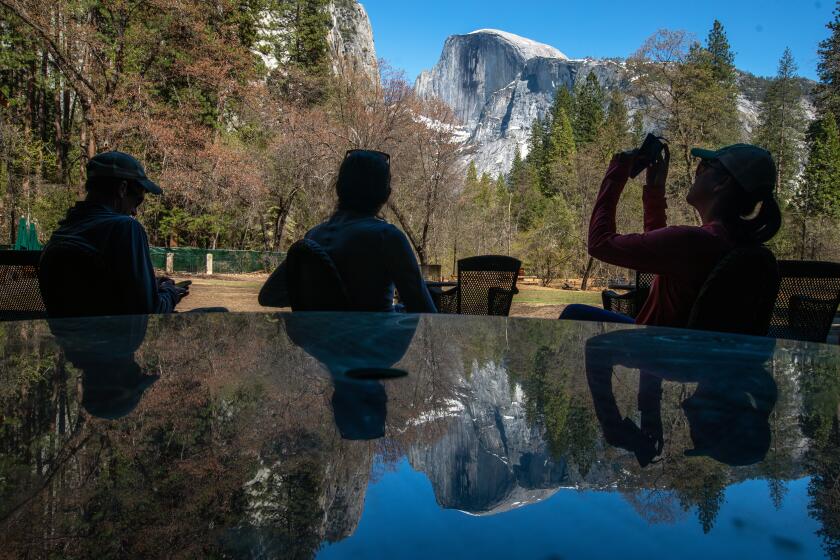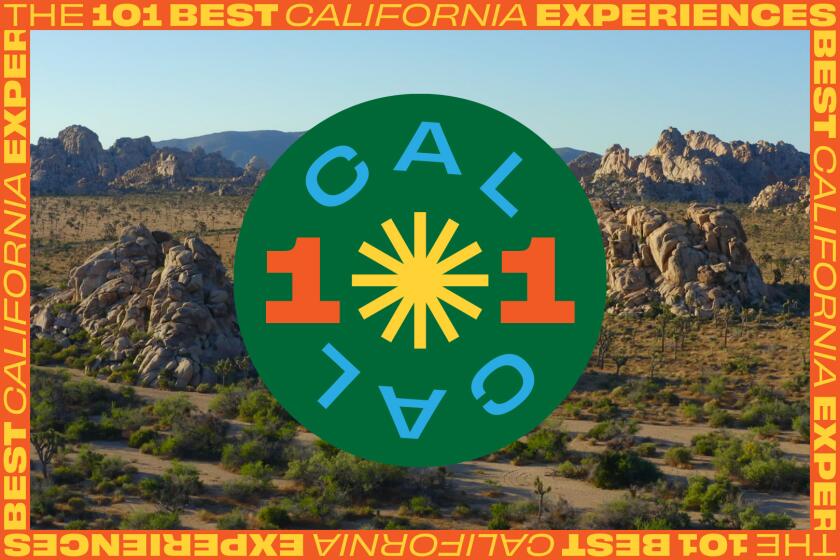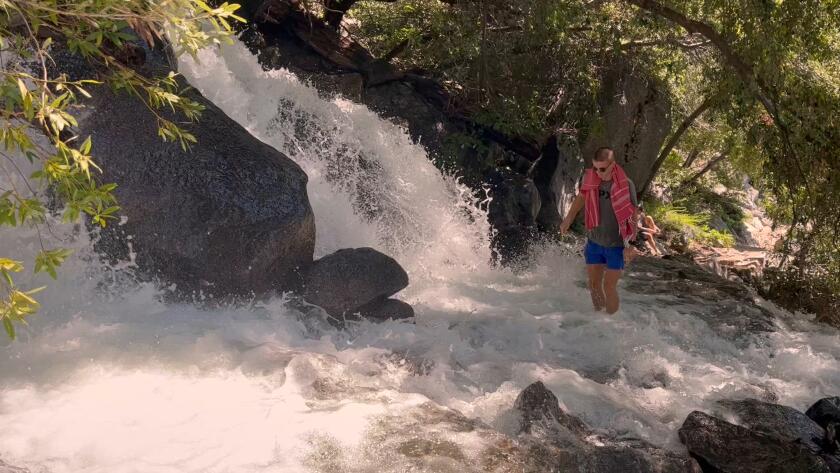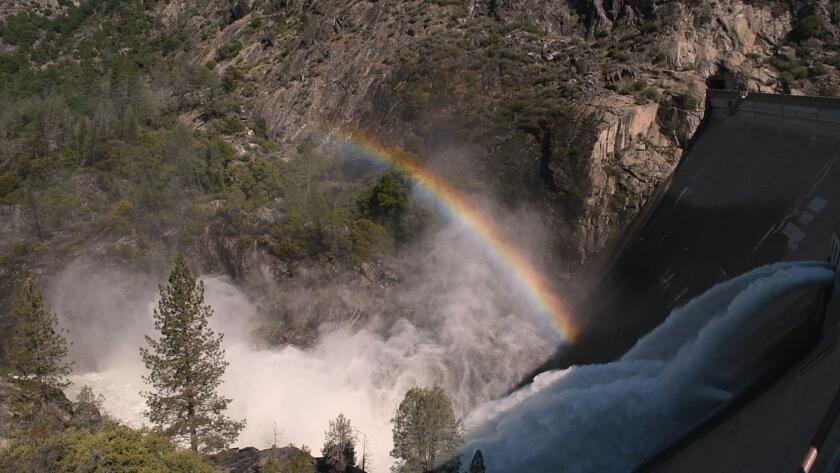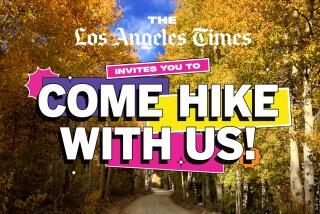
The water was winning. Fed by the heaviest Sierra snowmelt in decades, it gushed down the narrow valley’s walls and rushed across the trail in front of me. The bravest and most foolish hikers plunged on through, ice-cold whitewater up to their knees, a steep rocky drop below.
The rest of us paused — to think twice, and to drink in the scene. This was Yosemite National Park, but not the valley that most people visit.
Instead of Yosemite Valley, whose roads and parking lots have been choked with visitors for much of this summer, we were hiking the Hetch Hetchy Valley, a half-forgotten realm where the Tuolumne River was dammed in 1923 to feed San Francisco’s thirst.
Car lines out of Yosemite National Park have been at a standstill this summer as visitors, employees and locals report long waits to enter the park.
That project flooded some of John Muir’s favorite Sierra scenery and many still mourn that loss. But the valley is still part of the park. Visitors can walk across the top of 100-year-old O’Shaughnessy Dam and hike along the edge of the reservoir via the 5-mile round-trip trail to Wapama Falls.
The hikers who want a stiffer challenge can keep going past Wapama (whitewater permitting) to try the 13-mile round-trip to Rancheria Falls. Those looking for something short and steep do the Lookout Point Trail or descend to the Tuolumne River and climb back up on the aptly named Poopenaut Valley Trail.
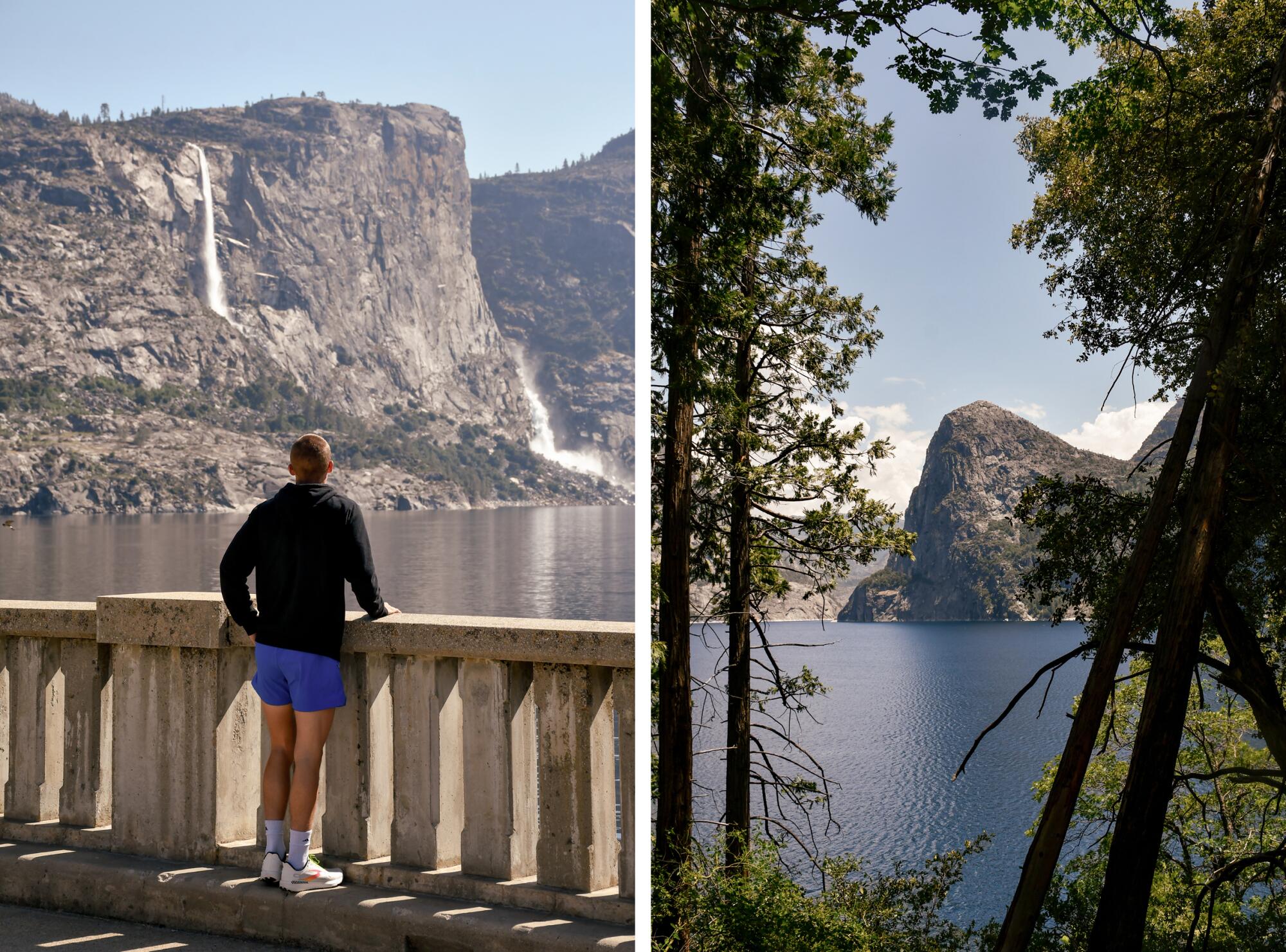
I focused on the Wapama Falls Trail. Granite walls? Check. Tall falls? Check (especially during my late June visit). Wildflowers? Absolutely. At about 3,900 feet above sea level, Hetchy is lower than most of the park, so its flowers bloom earlier and it has a longer hiking season.
You could say the water always wins here, because it fills the valley, or that it never truly does, because the dam holds it back. The reservoir is eight miles long and up to 306 feet deep. Besides providing drinking water for 2.7 million people, the Tuolumne’s downhill flow generates about 20% of San Francisco’s electricity.
Quantifying its effect on hikers is harder.
“It’s underrated,” attendant Bobby Williams told me at the activity desk of the nearby Evergreen Lodge. He highly recommended the Wapama Falls Trail — “but watch your footing,” he said. “A woman broke her ankle up there a few weeks ago.”
Before we go further, I’m not saying Hetch Hetchy is a substitute for the Yosemite Valley experience. There’s no camping unless you’re using Hetch Hetchy to begin a backpacking expedition. There’s no boating or swimming in the reservoir, by order of the San Francisco Public Utilities Commission, which runs the gravity-driven system that carries the water about 160 miles west to the Bay Area.
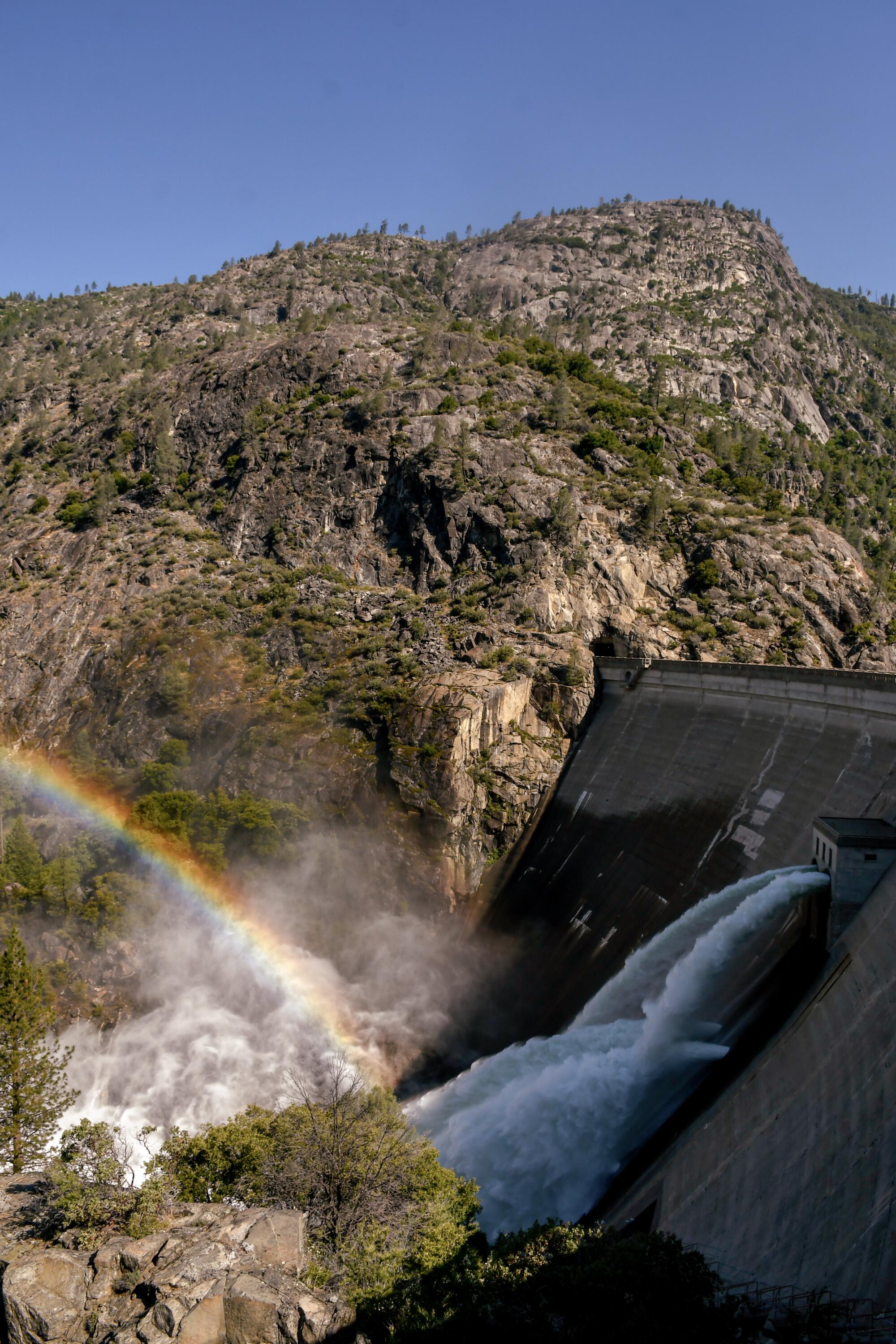
Also, on these summer days the valley’s roughly 150 parking spaces have often filled before noon, forcing later visitors to abandon their plans. It’s best to arrive soon after Hetch Hetchy Road opens at 7 a.m. (May 1 through Labor Day).
“As a local, I hope you won’t paint too rosy a picture,” retired ranger Laurel Munson Boyers told me.
Still, Hetch Hetchy has its own access road on the west side of the park and a lot fewer visitors than that other valley. It makes a great day trip if you’re already headed to Yosemite or Gold Country towns like Groveland, Jamestown, Sonora or Columbia. It’s a 38-mile drive from Yosemite Valley, 39 miles from Groveland’s Main Street. (And fishing is allowed from the reservoir’s shoreline.)
To reach the valley, I had headed north on I-5, as Yosemite visitors from Southern California usually do. But instead of entering the national park from the south on Highway 41, I arrived via Highways 49 and 120 (the latter also known as Big Oak Flat Road).
That first night, I stayed in a pre-pitched tent at the Evergreen Lodge, which was built 102 years ago to house the dam-builders. It’s an upscale family lodging now, with a swimming pool, massages and aromatherapy, the old gas station converted into a bike rental station. But the rustic woodwork and vintage photos in the tavern offer hints of the old days.
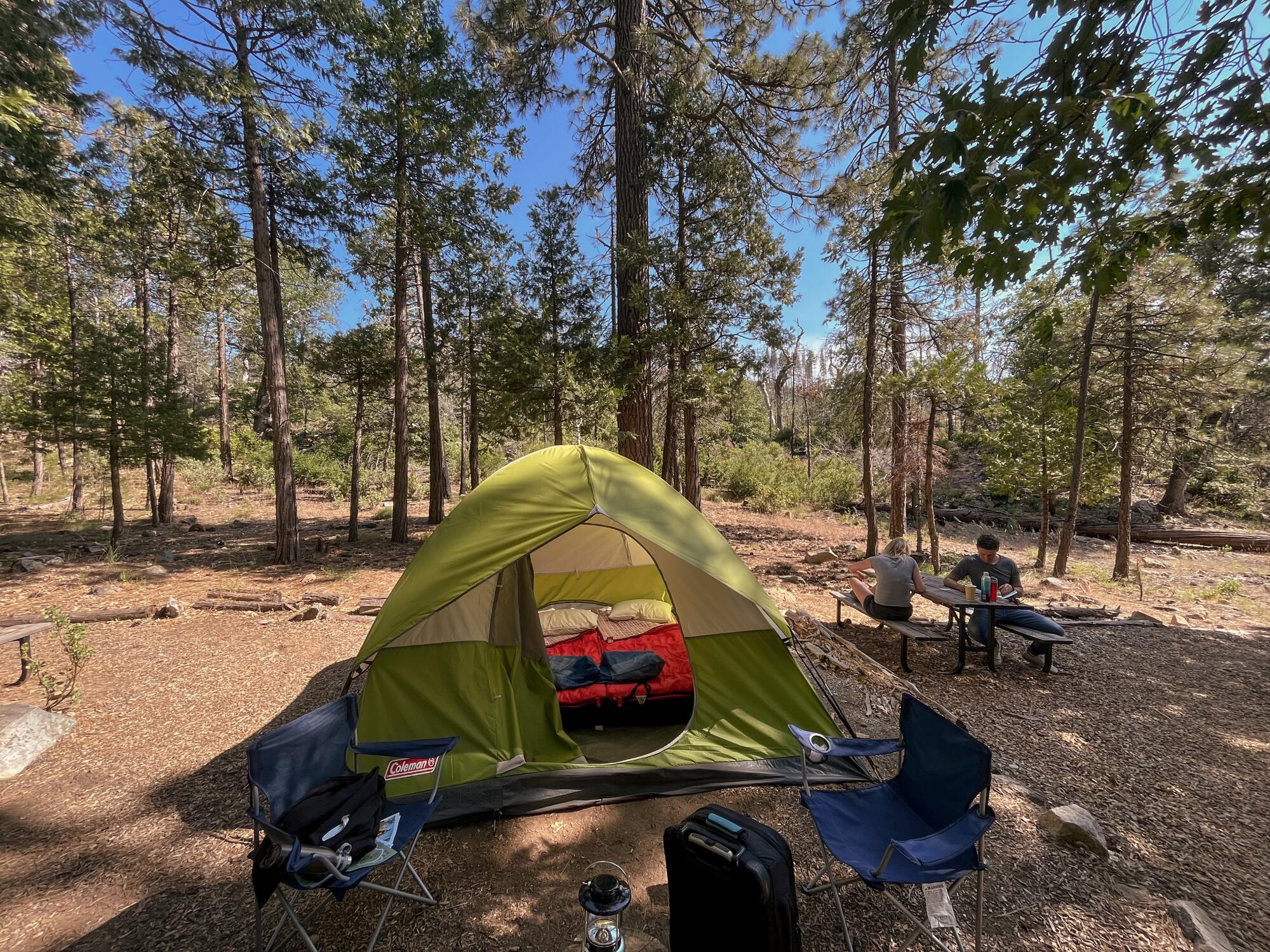
By 9:30 the next morning, I’d made the 10-mile drive from the lodge to the O’Shaughnessy Dam, where the Tuolumne is tamed and the Wapama Falls Trail begins. While waiting for rangers to clear a fallen tree from the road, I met Munson Boyers, who was headed into Hetch Hetchy with a friend to look at wildflowers.
What does she like so much about the valley?
“You’ll see,” she said with a knowing smile.
So I did. The first thing I saw after claiming a parking spot was a vivid rainbow hanging in the mist above the dam’s spillway. As we hikers strolled across the top of the 430-foot-high dam, we could see the downstream flow of the Tuolumne River.
In this drought-paused, restriction-lifted, spring-awakening moment, our state is ready for a good head-to-toe inspection. Come explore with us.
Above, we saw the reservoir-filled valley. And when you see that panorama, you realize why so many people describe Hetchy as Yosemite Valley’s little sibling.
The first thing you see is the vast and gently curving Kolana Rock, which reminded John Muir of Cathedral Rocks in Yosemite Valley.
The next landmark you notice is Wapama Rock, which looms like El Capitan (but 1,900 feet above the valley floor instead of 3,000).
Just left of Wapama Rock you see Wapama Falls, which comes down in stages like the taller Yosemite Falls, plummeting about 1,300 feet.
To the left of Wapama Falls is Tueeulala Falls, which typically roars in spring and peters out by midsummer. This year, there’s no telling how long it‘ll last.
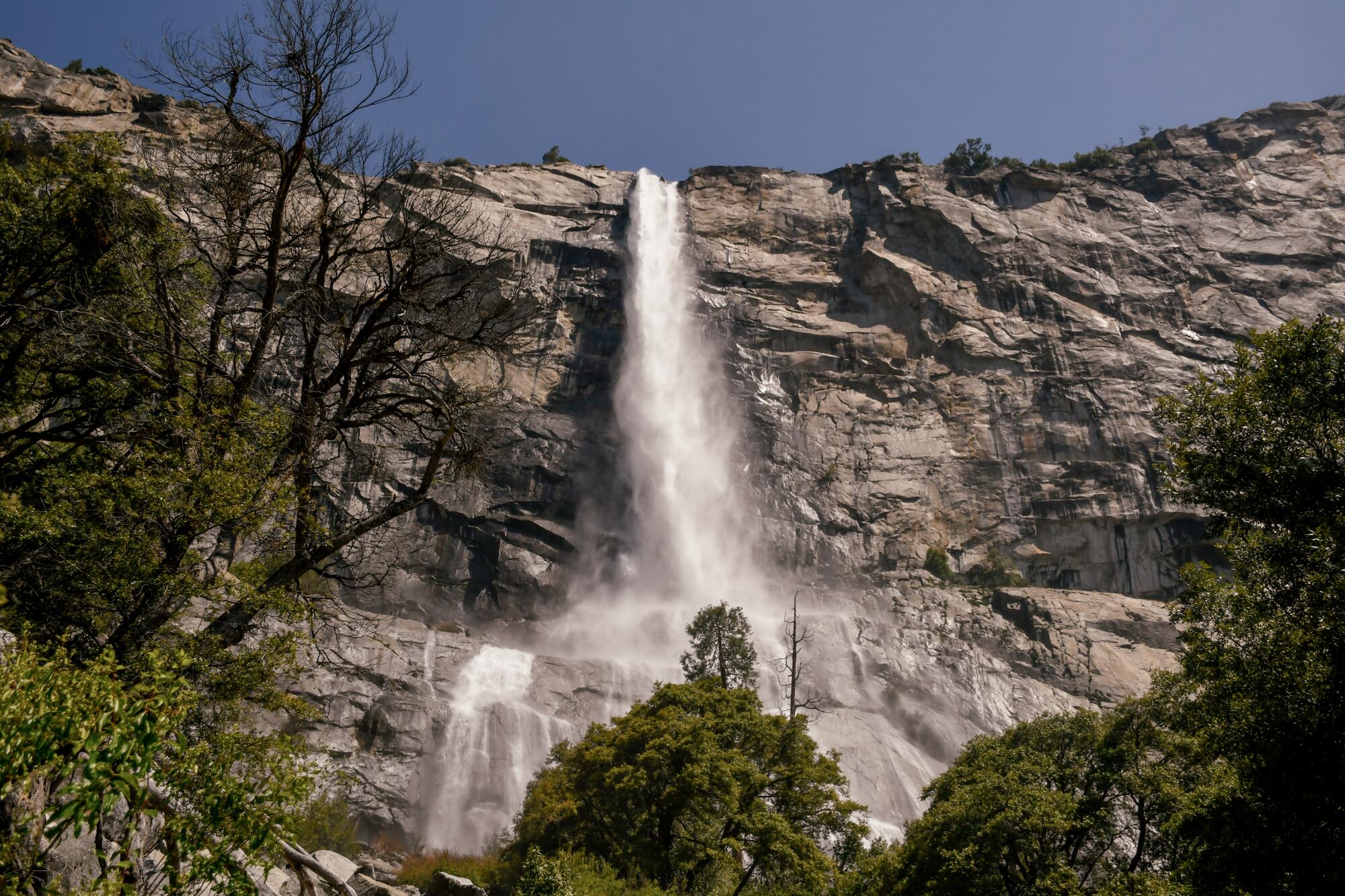
After you cross the dam, you walk through a tunnel that was dug by the dam-builders (and serves as one more reminder of the road into Yosemite Valley). From there, the trail twists and turns as more of the valley is revealed.
This stretch is great for families, broad and mostly flat, with wide vistas and rocks a kid might toss into the water. It’s like “a grand landscape garden, one of Nature’s rarest and most precious mountain temples,” John Muir wrote when the dam was still a debatable idea.
As you hike, you can’t help imagining the valley undammed — especially if you’ve been looking at “In Old Hetch Hetchy,” a profusely illustrated history published by Becky McCall last year, or if you’ve read “The Battle Over Hetch Hetchy” (2005) by Robert W. Righter.
Righter’s book explains how, seven years after the great quake and fire of 1906, San Francisco persuaded Congress to rewrite federal law and let the city build a dam in a national park. It also tells how Muir himself fought the dam and lost, and how that loss has shaped the Sierra Club and modern environmentalism.
“As an example of what should not be done to a scenic mountain valley,” Righter writes, “the story has no equal.”
That history also poses a challenge for the National Park Service as competing forces try to shape the valley’s future.
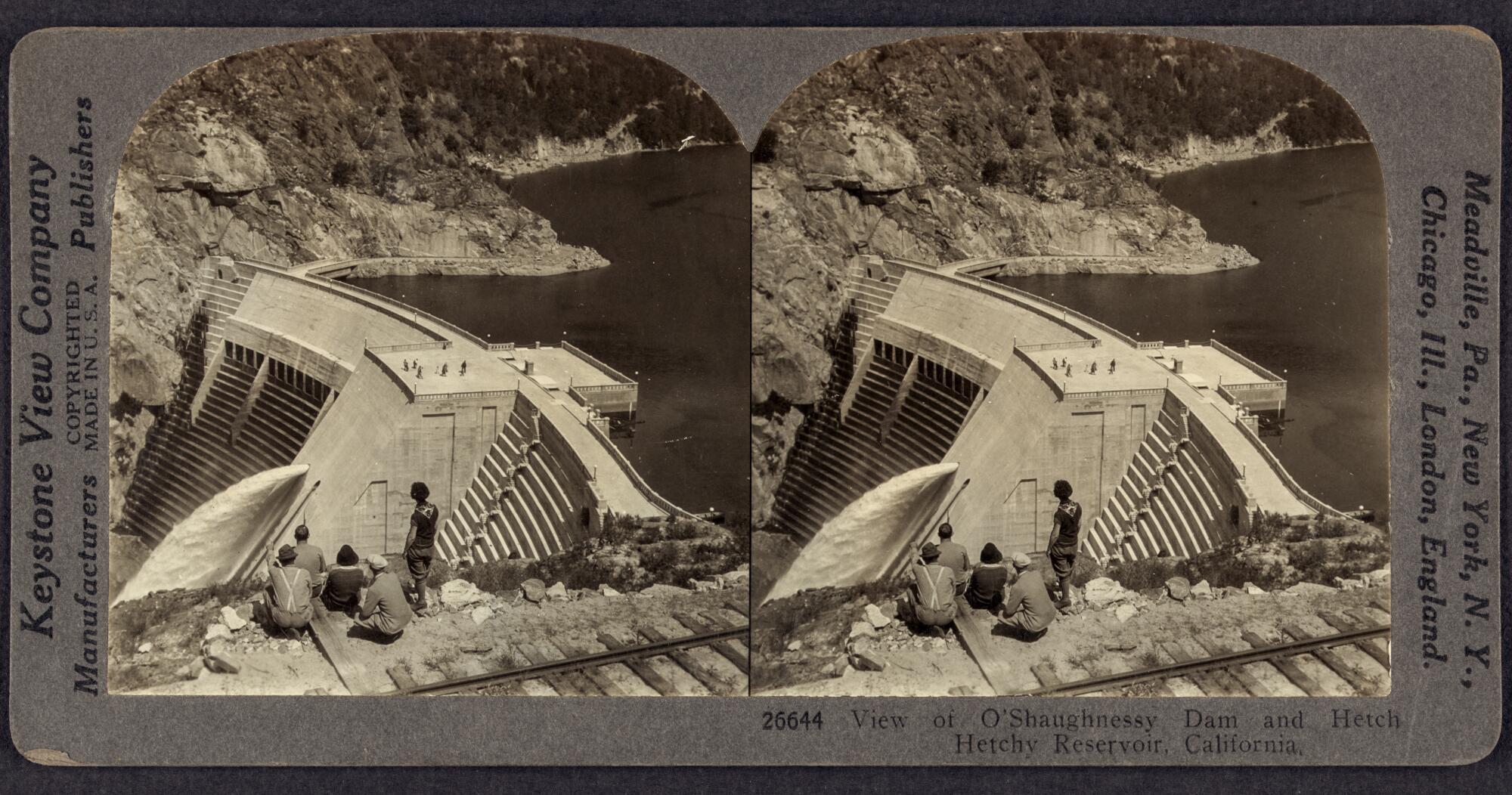
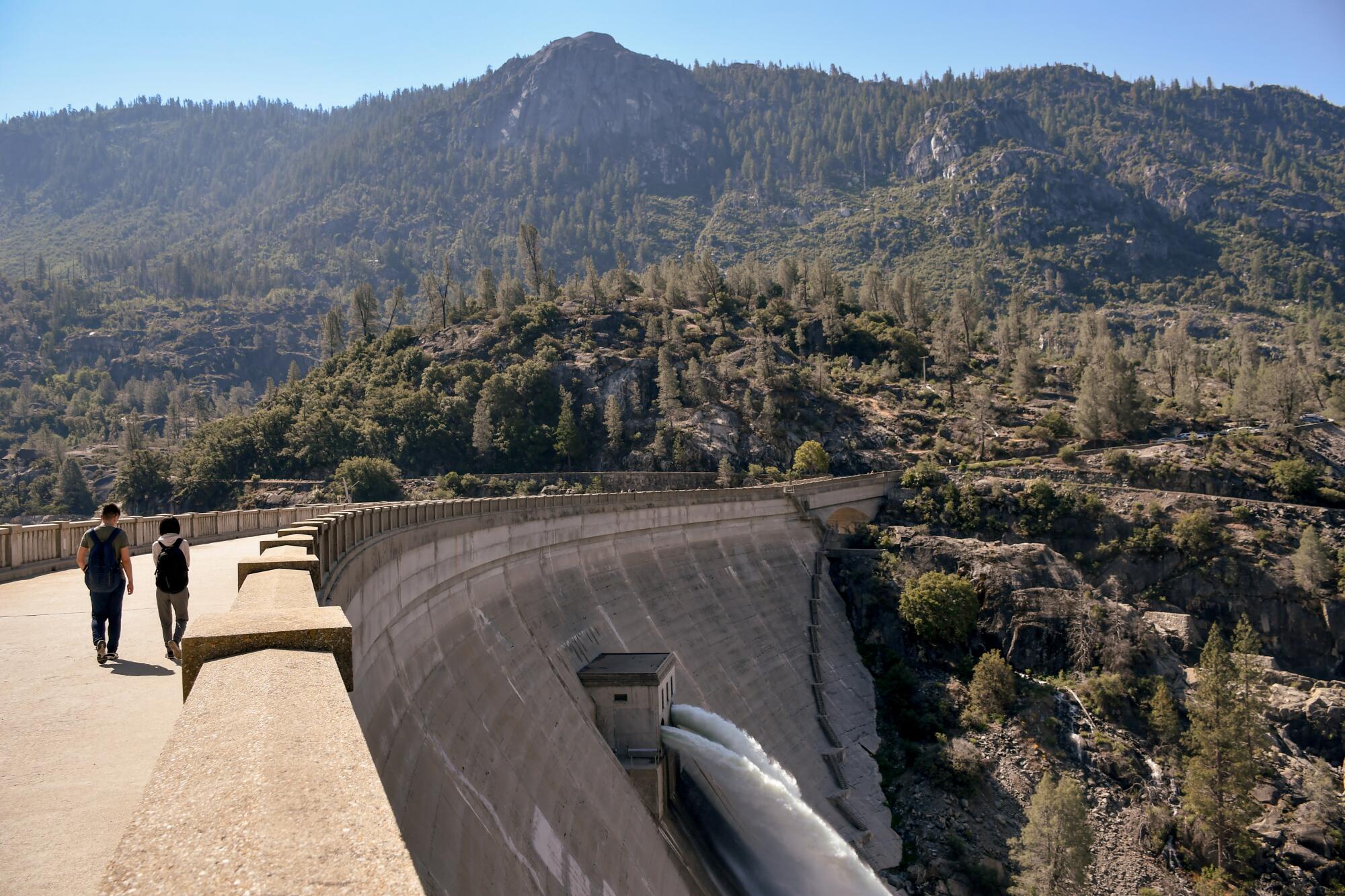
Restore Hetch Hetchy and some other environmental groups argue that it’s time to dismantle the dam and let the Bay Area get water elsewhere, perhaps from the much larger Don Pedro Reservoir farther downstream.
The San Francisco Public Utilities Commission, which controls the dam and reservoir, likes the valley as it is. So does U.S. Sen. Dianne Feinstein (D-Calif.), a former mayor of San Francisco.
If you live in San Francisco, Santa Clara, Alameda or San Mateo counties (and thus get water from Hetch Hetchy), you might well agree with them. How many Angelenos, after all, are ready to let go of the water that the L.A. Department of Water and Power has been rerouting from the Owens Valley since 1913?
After about two miles, the trail began to offer up tantalizing views of the top of Tueeulala Falls. Then suddenly the falls’ overflow was upon us, runoff splashing across the trail.
I remembered the Yosemite rangers’ all-purpose advice for hikers this spring and summer: “Use extreme caution anywhere near flowing water.” But the first wet patch wasn’t much to worry about. In fact, it was pleasant on a hot day.
Some hikers pulled off their boots and crossed barefoot. Others, like me, had brought water shoes in their backpacks. No problem.
The second wet patch was different. Before I saw it, I heard an offhand warning from a man who was heading back.
“There’s a gnarly bit,” he said. Which would have been worrisome enough in itself, but he said it with a legit Australian accent.
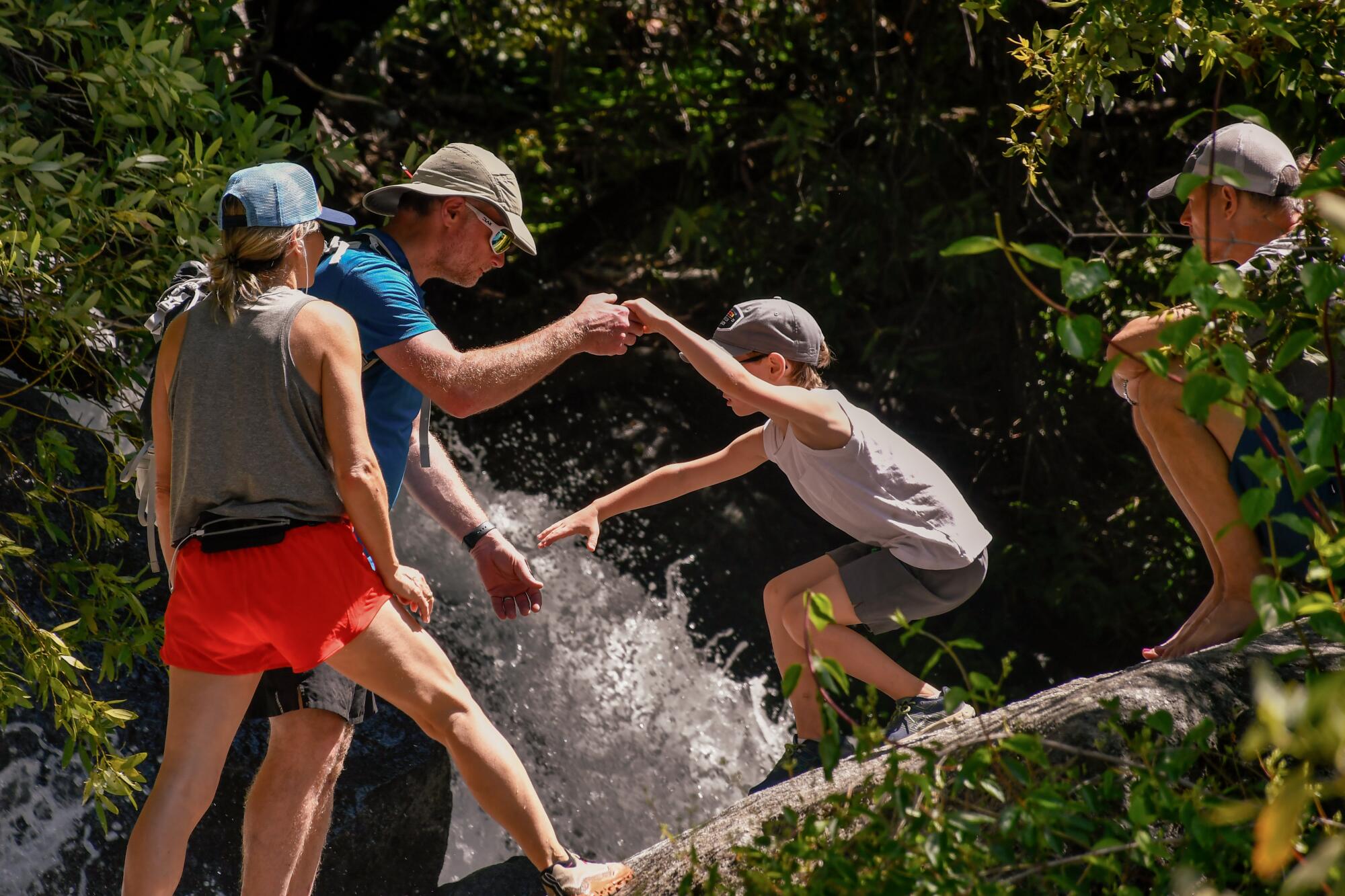
Gnarly it was. It was essentially a creek cutting across the stony trail. While the boldest hikers splashed their way through, the rest of us lingered in the shade, nibbled snacks, plotted strategy or just turned right around.
After a few minutes of observation, I stepped in — and within four steps on the uneven path was a bit more than knee-deep in whitewater. The current tugged at my hiking poles, which I’d been expecting to add stability, not undermine it. I aborted the mission and retreated.
So did a young dad carrying his child. Then came a husband about 60, who bulled his way across while his wife waited on the safe side. I didn’t see anyone fall, but I saw many close calls.
“I had to take that first step,” said Kevin Lam, 32, of Dublin in Alameda County, who made it through. Lam was enjoying the valley, he said, because “it’s less crowded and the views are amazing. ... And it’s also good to learn where we get our fresh water from. I’ve read little stories about it here and there, but I never thought it was like this.”
Just a few yards beyond my stopping point, hikers reach the best views of Wapama Falls and cross a series of short footbridges over Falls Creek — if the water will allow it. Four hikers died in high, fast water at the Wapama footbridges between 2011 and 2019. The park service has plans to boost safety measures at the bridges, but the timetable is uncertain.
As of July 18, the reservoir was 98% full, up 6% from the day of my visit. The state of the trail is impossible to predict because of the variability of temperature and snowmelt, but in coming weeks and months, Tueeulala Falls is bound to dwindle and vanish. The trail and footbridges will be an easy walk again.
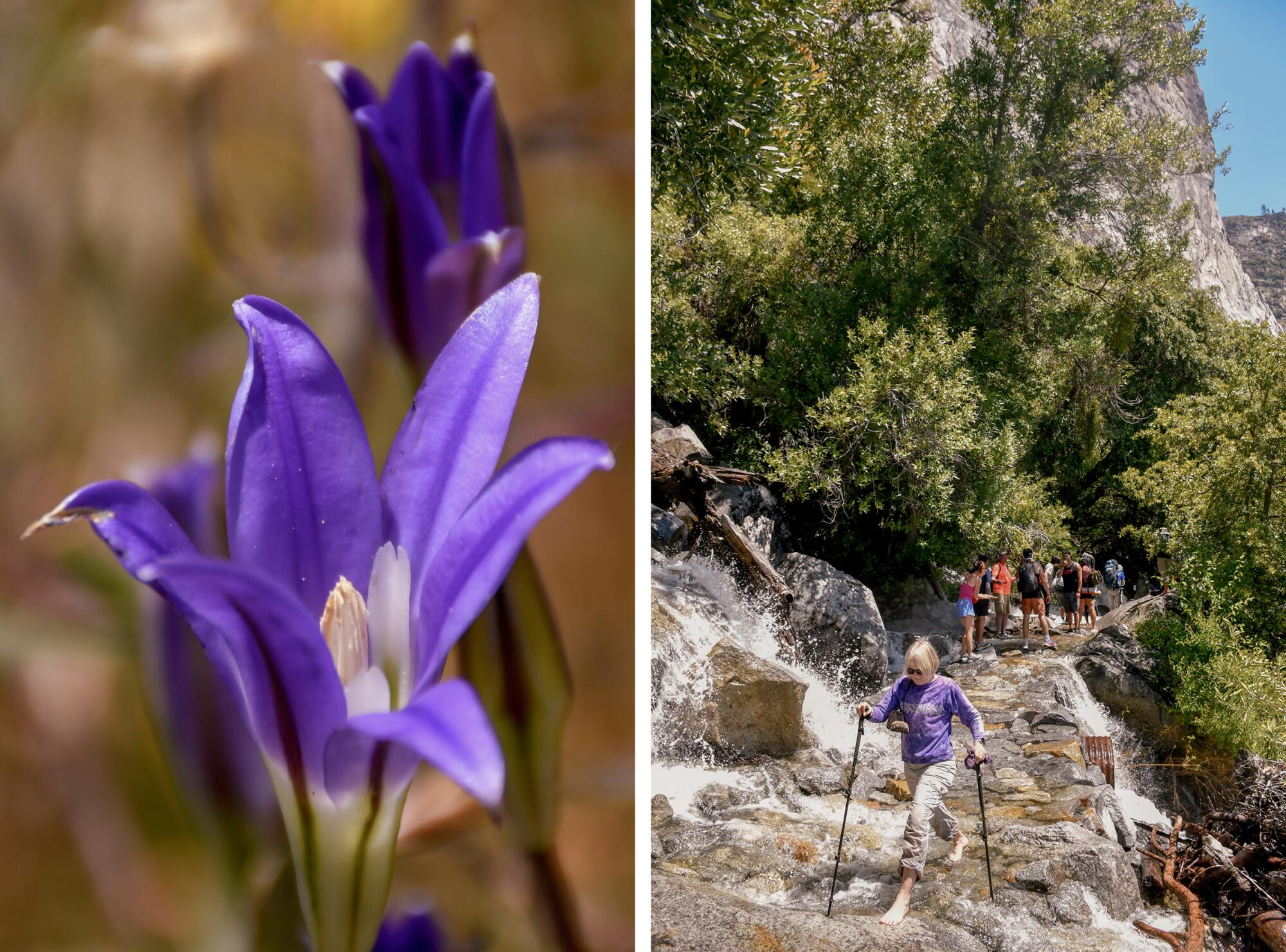
But I have to say, part of me was glad to see the waters of Hetch Hetchy having their way with the valley, if only briefly. And all of me was grateful to see a corner of the park, and a window into California history, that I’d never seen before.
I’m clearly not the only one. On the way back out, I crossed paths with Mike Miller, a firefighter from the Modesto area, who had paused on the stony path to look at the water and canyon walls.
“Fifty-one years old in the Central Valley and I’ve never been,” he said. He’d come to Hetch Hetchy to dodge the crowds in Yosemite Valley, he said. And now that he’s seen Hetch Hetchy, “I don’t know if I want anybody else to know about this place.”
If you go
Be sure to check for updates on roads and weather from Yosemite National Park, where admission is $35 per car. On July 22, the park opened its Tioga Road entrance after a long seasonal snow closure. The move may ease crowding on park roads. Still, rangers warn that this summer, the first in four years with no reservation requirement for day-trippers, visitors should “be prepared for multi-hour delays at park entrances and traffic congestion, especially in Yosemite Valley.”
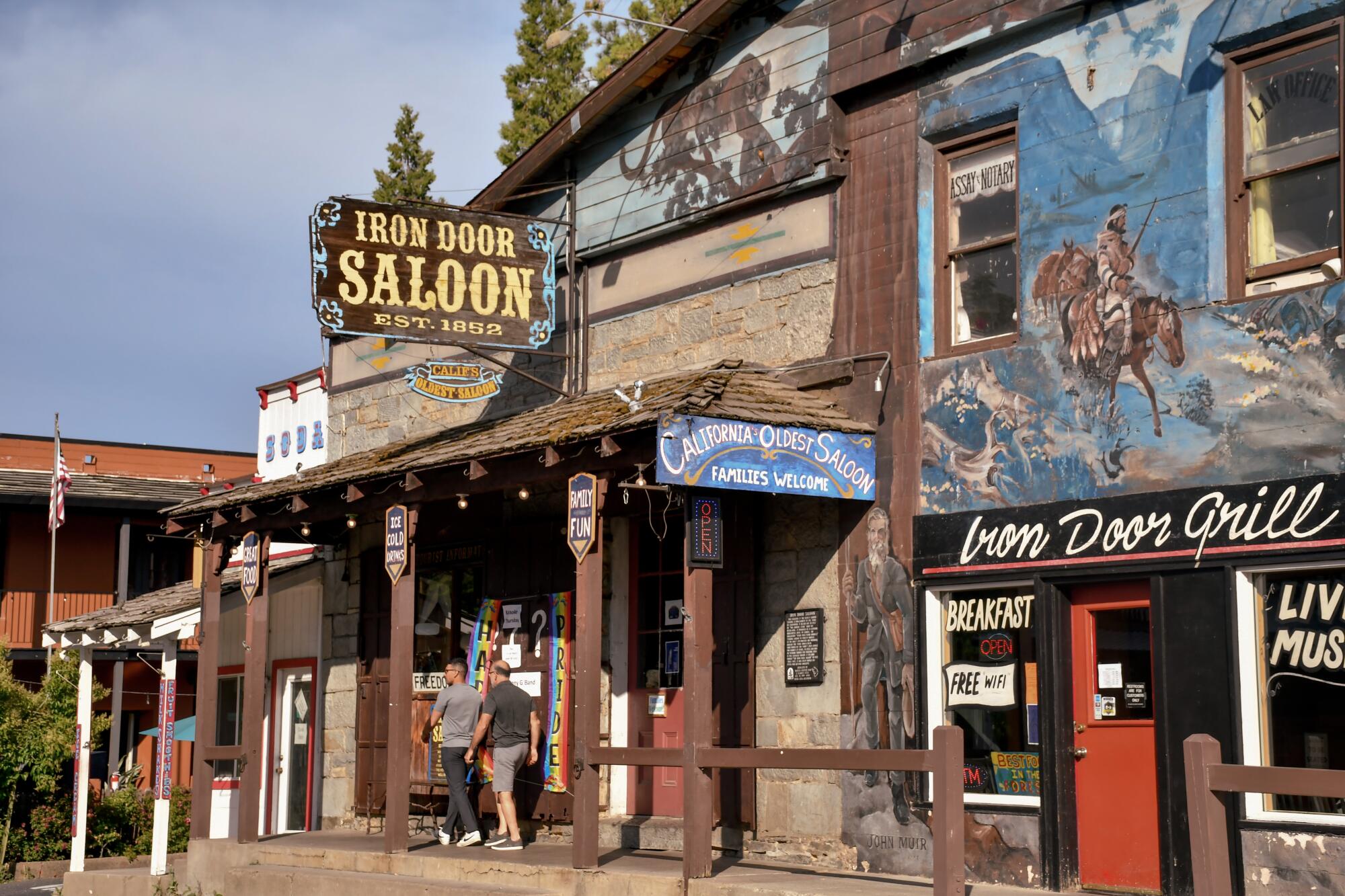
Where to eat and drink
- The Iron Door Saloon,18761 Main St., Groveland, housed within the granite walls of a pre-1852 building, claims to be the oldest saloon in California. It looks the part, its high ceiling covered in dollar bills. Lunch and dinner are served daily (and breakfast Friday through Tuesday) and there’s often live music on weekends.
- Cocina Michoacana,18730 Main St., Groveland, has an unexciting facade, but the interior is pleasant and the food is good and hearty. Open 10 a.m. to 10 p.m. Monday through Saturday.
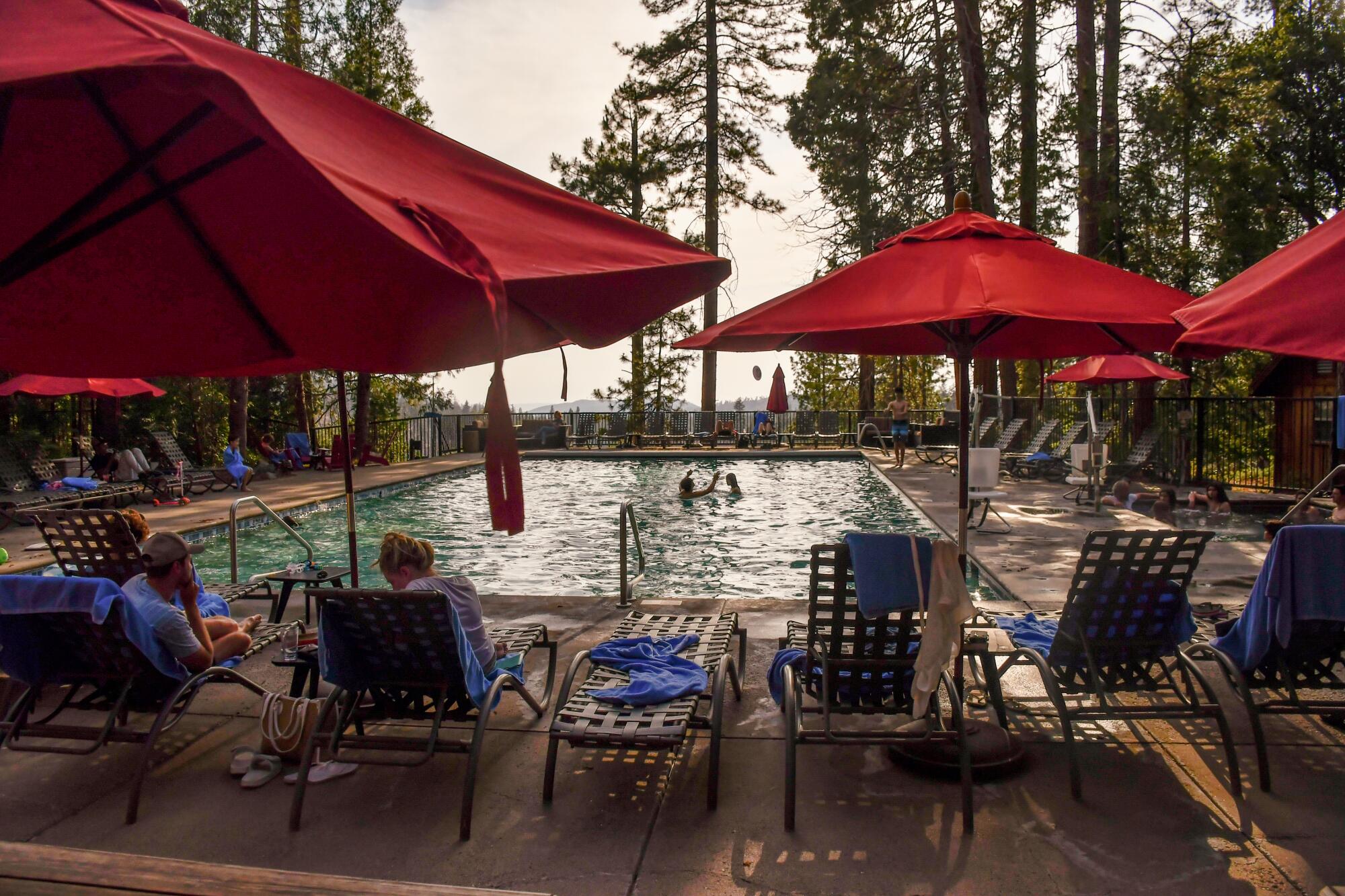
Where to sleep
- The Evergreen Lodge, 33160 Evergreen Road, Groveland, was built in 1921 and dramatically upgraded in the 2010s. It includes 88 cabins (about $225-$625 this summer) and about a dozen “custom camping” tents ($130-$165) on 20 acres. It includes a tavern, pool and bike rentals. It’s about 10 miles to Hetch Hetchy’s O’Shaughnessy Dam, about 30 miles to Yosemite Valley. It also has a nearby and upscale young sibling, Rush Creek Lodge & Spa, which opened with 143 units on 20 acres in 2016.
- Groveland Hotel, 18767 Main St., Groveland, has 18 rooms and suites with a historic feel, with summer rates of roughly $240-$300. Its restaurant, Provisions, is open 2 p.m. to 9 p.m. Wednesday through Sunday in summer.
- Hotel Charlotte, 18736 Main St., Groveland, has 13 rooms, an Old West vibe and summer rates of roughly $240-$300. Charlotte’s Tavern is open for dinner 5 p.m. to 9 p.m. Sunday through Thursday.
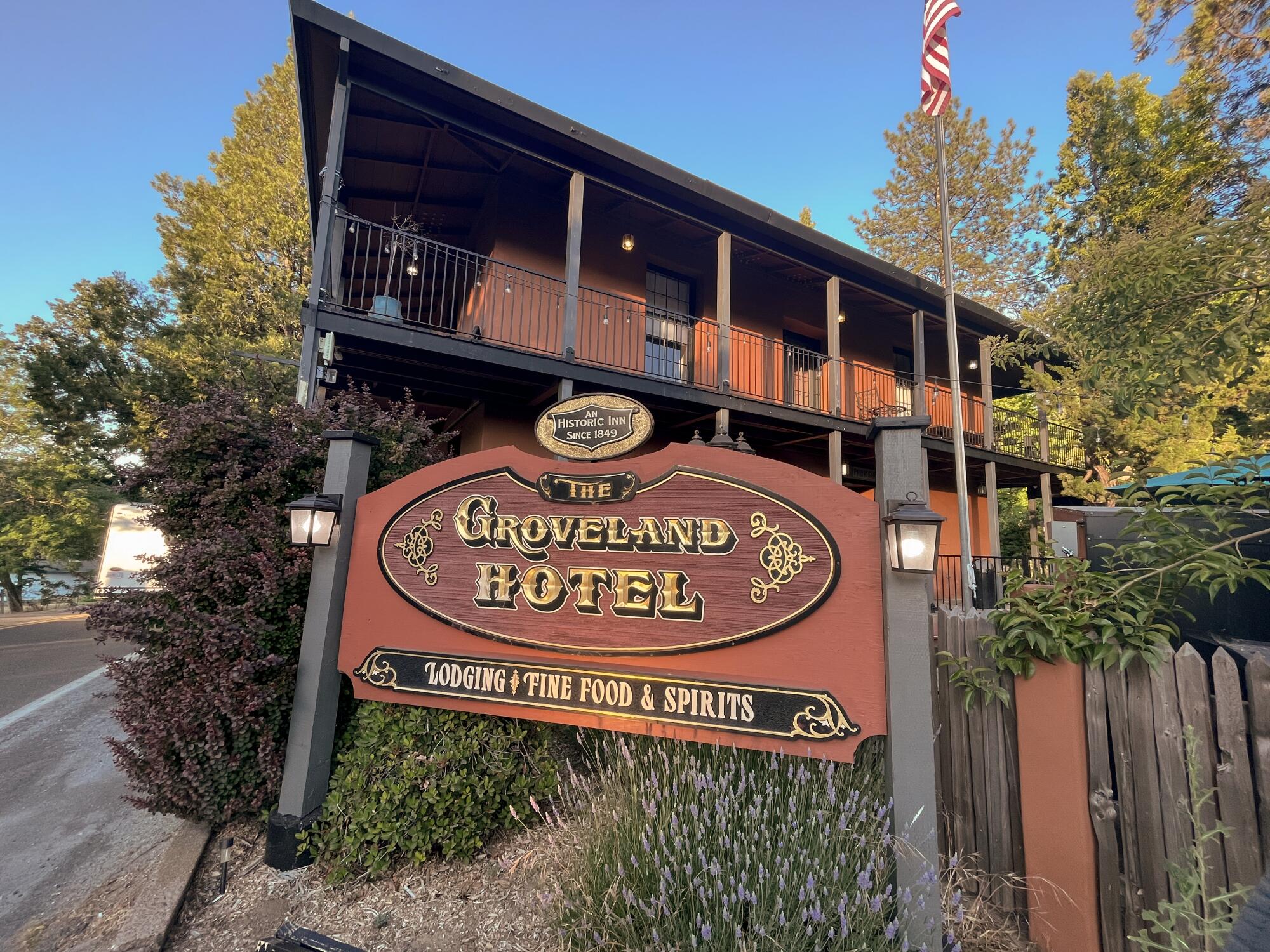
What to do
- Camp Mather, 35250 Mather Road, Groveland. Just as San Francisco runs the Hetch Hetchy Reservoir, it owns and operates the 340-acre Camp Mather, which lies about a mile from O’Shaughnessy Dam and once housed the sawmill serving dam construction. Now it’s a rustic, if not threadbare, family camp — and demand is so high for its affordable cabins that applications are selected by lottery. (San Franciscans get preference and better prices.) With a $19 day pass, you get access to games, fishing and swimming in Birch Lake. On weekends, unfortunately, the access doesn’t begin until 2 p.m. For $80, reservations recommended, you can try an hourlong guided horseback ride from adjacent Chaparral Ranch.
More to Read
Sign up for The Wild
We’ll help you find the best places to hike, bike and run, as well as the perfect silent spots for meditation and yoga.
You may occasionally receive promotional content from the Los Angeles Times.
